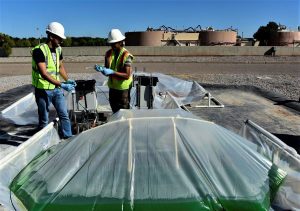By: Linda Fresques
 |
Over the past decade, New Mexico State University (NMSU) College of Engineering Professor Nagamany Nirmalakhandan (known as Dr. Khandan) has investigated how algae – yes, that simple green stuff that grows in stagnant water – removes contaminants from wastewater.
The specific microalgae used by Dr. Khandan and his team of dedicated graduate students comes from hot springs in Yellowstone National Park and can thrive in 110-degree temperatures while consuming organic carbon, nitrogen, and phosphorous found in wastewater. By doing that it cleans wastewater making it suitable for discharge into waterways. The algae’s chemical reactions are fueled by the sun – free and abundant in our region.
However, over the last six months, this team has observed an unexpected and dramatic new result. The algae also destroys potentially disease-causing pathogens in wastewater.
Traditionally, municipal wastewater treatment facilities have added chlorine to kill pathogens in the wastewater. Yet over the last ten years, researchers have discerned a negative side effect. The chlorine has the potential to form carcinogenic – that is, possibly cancer causing – by-products. Now, the race is on to find new solutions, and one might involve Dr. Khandan’s algae fueled by the sun.
“Our team found that the algae fights for dominance in our system,” explains Dr. Khandan, “And potentially changes the belief that scientists have previously held regarding how algae can operate.”
This research is possible thanks to the collaboration between Las Cruces Utilities (LCU) and the NMSU College of Engineering. Now scientists around the world may see new potential in simple single-celled algae.
The Jacob A. Hands Wastewater Treatment Facility (JHWWTF) in Las Cruces processes an annual 3.3 billion gallons of sewage from the sinks, showers, and toilets. Also onsite at the JHWWTF are 200-gallon plastic tanks that are home to an army of algae thriving in wastewater and monitored by the NMSU research team. “This research has global implications for wastewater management in sunbelt regions that are hot and dry,” Khandan explains.
Along with NMSU faculty member Dr. Yanyan Zhang, whose research interest includes pathogen detection and inactivation, and students Himali Delanka-Pedige and Srimali Munasinghe-Arachchige, both NMSU Master’s graduate students in their second semester, Dr. Khandan wants to now try and figure out the exact mechanisms by which algae seeks out and destroys the pathogens.
“It’s been exciting to see something we’re doing go from theory to the lab to something practical,” said Himali. Srimali agrees and sees the future, “If this can be implemented on the large scale, it will be incredibly cost effective.”
LCU has been an easy partner in the research, allowing faculty and students access to the facility to monitor the algae. The research was originally funded by the National Science Foundation for Reinventing the Nation’s Urban Water Infrastructure and the Department of Energy with $5 million that has been extended with an additional $3 million to take the studies through 2021. A long-term study may be able to pinpoint what all algae can do, and its first beneficiaries will be the residents of Las Cruces.
Submitted by Las Cruces Utilities
